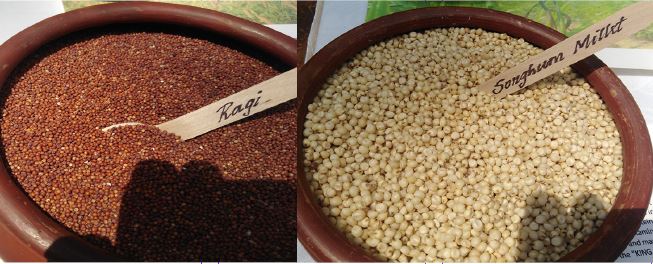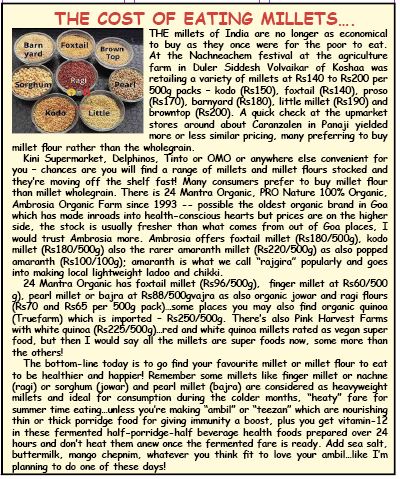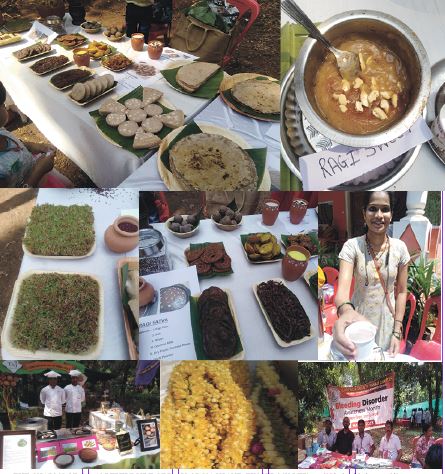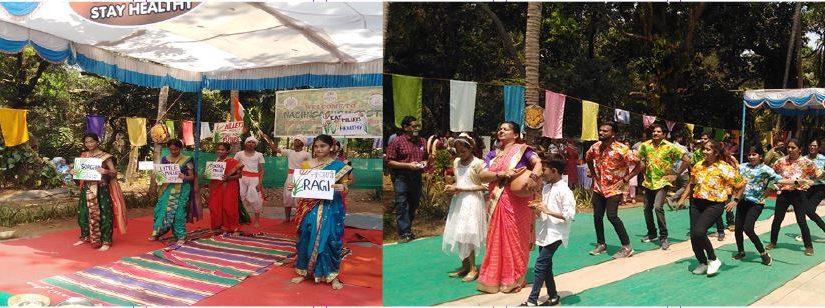AT THE NACHNEACHEM FEST at Duler Agriculture Farm on March 12, 2023…getting to know Goa’s favourite millet, nachne or ragi (otherwise finger millet). Cultural and educational programs included singing, dancing, exhibition of millets and millet flakes becoming popular now, demonstration of nachneachem recipes and of course sale of millets, tasting “ambil” and “teezan” and buying home savoury and sweet snacks most of which were made of millets and especially Goan nachne (finger millet)..
By Pankajbala R Patel
Where is it going to take us? Will it mean the rich will eat millets and enjoy better health, while the poor will be able to afford rice and wheat – but not millets now priced at higher rates because they are becoming popular for healthier reasons!
FUNNY or not funny. But it has always been like this and the repeats get more and more sophisticated, that’s all. We don’t even realize it, or do we but pretend we don’t know and don’t care? Who are the victims this time? I dare say farmers continue to be at the bottom of the economic pyramid of food unless some of them have become farmers in name only!
I have been asking myself why all this celebrations and festivals and tom-tom of magical millets, mighty millets, eat more millets and grow healthy – the country over? And since these messages are coming from the top seeming from the fountains of political wisdom….there’s every reason to be cautious today!
What is funny is until recently the rich of the country shunned millets as the food of the poor – and now suddenly the richer classes are looking for the nine mighty millets to eat and live forever! Poor farmers are urged not to give up and abandon their traditional time-test cultivation of the hardy millets for there is going to be a big runaway market for them in the country with many middlemen desperate to make money exporting millets to the rest of the world where they can afford to eat millets.
See the irony in all this. To date only the poor farmed millets on their pocket farms to harvest the millets for personal family consumption. But today both Central and State government are busy promoting millets for health and the price of millets have shot up because as usual only the rich can eat afford them! The poor once ate lowly-priced millets with gratitude and enjoyed robust health, but now they think rice and wheat is so much more affordable why not eat like the rich used to eat! Rice and wheat, it’s a status symbol to eat rice and wheat, not millets!

CHANGING EATING HABITS
MOST of the time the people at the bottom of the economic ladder of life are eating refined flour or cheap atta and cereals purchased at subsidized rates at the government ration shops – which they stand in queue endlessly to buy upon displaying their BPL card given to them by the local Mamlatdar’s office. Millets? The story is the lowly-priced millets are no longer lowly-priced and from Rs20 and Rs40 a kilo they’re in the Rs150 kg plus, plus bracket today and our educated rich are busy buying them up and feasting on them morning, noon and night — so that they may live forever while the poor may die or something like that!
Don’t take this with a pinch of salt. In the new economical re-stucturing coming from the top we’ll soon hear of millet barons skimming the profits rolling in from millet cultivation on their farms. Undoubtedly, the Agricultural department of the government has several schemes to help small farmers to revive and increase their acreage for cutlivation millets. The upmarket stockists are waiting with baited breath for the demand for healthy millets is growing…the word has spread.
Millets are low-glycemic, more alkaline upon digestion, richer in protein and mineral values and higher in fibre. Also, they are not refined to death like rice and wheat are for a gamut of mainstay foods and snacks sold in local shops and the upper crust mega marts. It is pertinent to note that as part of the International Year of Millets 2023 the Directorate of Agriculture (government of Goa) held an exclusive day long Nachneachem Festival at the Duler agriculture farm in Mapusa on March 12, 2023. It was curated by festakars Marius Fernandes and Dr Gwendolyn De Ornelas.
Of course this festival focussed exclusively on nachne or ragi which is Goa’s favourite millet, apart from the Kannadigga settlers originally from neighbouring Karnataka who prefer to eat jowar roti. In Goa most rural homes will serve nachnea or ragi roti/bhakri for cooler evening meals, we are talking of finger millet here, one of the smaller millets which are considered to be warming, protein and mineral rich…it has been heard before that if you switch over to eating two nachnea bhakri a day it would go a long way to slim you down and get in shape! Many have started believing in it and switched over from wheat roti/ bhakri to nachnea bhakri and speak highly of the benefits.

AT NACHNEACHEM FESTIVAL
BUT to stay with the Nachneachem Festival it was a happy occasion to clue oneself up on Goa’s favourite millet. The reddish finger millet is popular for making sattvo (a favourite Goan custard-styled sweet in Saraswat Brahmin homes, and it is more full of flavour than any dairy custard) and the tribal Gaudi people’s homes “ambil” is a must drink staple…while Catholic homes influenced by Portuguese culture do tizan. Both porridge-styled drinks are delicious when correctly made – ambil has incredible agreeable tart flavour while tizan with coconut or caju milk in sweetish slightly. Both are considered sacred tonics in old-fashioned homes in Goa, respectively. The migrant Hindu communities from neighbouring Maharashtra and Karnataka do not indulge in either ambil or tizan unless influenced by Goan ways over time…some folk think tizan is upper crust porridge while ambil is what the poorer castes take to stay robust in health.
Both porridges were being served at the Nacheachem Festival and I may tell you the ambil is utterly delicious with its tart notes, takes some skill to soak the nachne over two days and extract the fermented sourish juice though…delectable to drink I dare say on hot afternoons in Goa to chill. Tizan is agreeable too. There was lots of stuff on display and for sale including millets – especially at the Koshaa table where the entrepreneurial Siddesh Valvaikar had a fascinating millet flakes (poha) too. Down south India he says the farmers are branching out into turning various millets into flakes too and these may be eaten exactly we eat rice flakes, corn flakes, etc. Crunchy and delicious the finger millet flakes were selling Rs150 per pack.
At the Bardez Taluka Farmers Producer Co Ltd table there was Dhiraj Naik explaining to visitors about their mission to help farmers to create a modern ecosystem for agriculture, they have some very sound offers, you want to look them up if you’ve a yen to be a farmer. I found the best nachneachem ladoo, utterly delicious and light-hearted without the use of too much fat (desi ghee, definitely not some vegetarian hydrogenated fat). I bought a packet of rice-finger millet (nachnea/ragi) mix flour for Dhiraj here said, “It’s better for making chapatty.”
As it got closer to lunchtime the hungry feasted on the preparations brought from home or prepared on the spot – I relished Ashwini Chodankar’s soft jowari bhakri with vangi bhaji, scrumptious thetcha; there were all kinds of other snacks too made of millets …Dhanashree Phadake’s Swadisht Vyanjan from Colvale was offering ambil for everyone to taste and I bought some superlatively good puran poli and methi thepla. The Taj Holiday Village were all set to demonstrate how to turn out perfect hot pancakes from nachneachem batter…but I didn’t stay to see or learn. Elsewhere there was millet and non-millet food, music, dancing, workshops, pep talks on how to introduce the millets into one’s eating habits to enjoy more health and so on and so forth.
Needless to say and to repeat anew it is Prime Minister Narendra Modi who is behind the United Nations declaration of 2023 being the International Year of Millets. Of course all with the aim of understanding and celebrating one of the most ancient grass seeds or grains of food, which people have eaten since the beginning of time or since they discovered how millets could be cultivated for food…somewhere along the way the industrial revolution started promoting wheat and rice, millets were forgotten.
Now I don’t know whether it’s good that the classes have discovered them with vengeance or not! I pray the poor continue to eat millets and not abandon them for cheaper wheat and rice thinking it is “rich people’s food.” Funny how the not so rich think the rich are worth emulating to get on in life!
Glimpses of Nacheachem fest…

